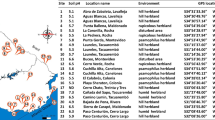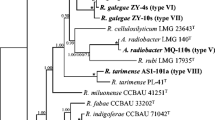Abstract
In the Western Canary Islands, Myrica faya and Myrica rivas-martinezii (Myricaceae) are phylogenetically close, endemic, actinorhizal species presumed to be remnants either of the European or the African Tertiary floras. Unisolated Frankia strains from field-collected nodules on Tenerife, Gomera, and La Palma Islands were compared by their rrs gene and 16S–23S intergenic spacer (IGS) restriction patterns. To compare the genetic diversity of Frankia strains from within and outside the host’s native range, nodules of M. faya field plants were collected both in Canary Islands and in Hawaii, where this species is an exotic invasive. Myrica rivas-martinezii, endemic to the Canary Islands, was sparsely nodulated in the field. Frankia strains harbored in field-collected nodules of M. faya and M. rivas-martinezii belonged to the Elaeagnaceae strains’ genetic cluster and exhibited a high degree of diversity. Frankia genotypes were specific to each host species. In the Canary archipelago, we found no relationship between site of collection and Frankia genotype for M. faya. The only exceptions were strains from site 2 in Tenerife, a location with a geological history different from the other sites sampled. Hawaiian and Canarian M. faya strains had no genotypes in common, raising questions concerning the origin of M. faya-infective Frankia in Hawaii. Nodular strains of M. rivas-martinezii from nursery plants were genetically characterized and shown to be divergent from the strains of field-collected nodules and belong to the Alnus-Casuarina strains cluster. This suggests Myrica may have the potential to nodulate with a broader range of Frankia genotypes under artificial conditions than has been detected in field-collected nodules.


Similar content being viewed by others
References
Arveby AS, Huss-Danell K (1988) Presence and dispersal of infective Frankia in peat and meadows soils in Sweden. Biol Fertil Soils 6:39–44
Benson DR, Hanna D (1983) Frankia diversity in an alder stand as estimated by sodium dodecyl sulfate–polyacrylamide gel electrophoresis of whole-cell proteins. Can J Bot 61:2919–2923
Bosco M, Fernandez MP, Simonet P, Materassi R, Normand P (1992) Evidence that some Frankia sp. strains are able to cross boundaries between Alnus and Elaeagnus host specificity groups. Appl Environ Microbiol 58:1569–1576
Bramwell, D, Bramwell, ZI (1974) Wild flowers of the Canary Islands. In: Excelentisimo Cabildo Insular de Tenerife. Stanley Thornes Publishers, Ltd., London
Chevalier A (1901) Monographic des Myricaceae; anatomic et histologie, organographie, classification et description des espèces, distribution geographique. Mém Soc Natl Sci Nat Math Cherbourg 32:85–340
Clawson ML, Benson DR (1999) Natural diversity of Frankia in actinorhizal root nodules from promiscuous hosts in the Myricaceae. Appl Environ Microbiol 65:4521–4527
Dawson JO, Kowalski DG, Dart PJ (1989) Variation with soil depth, topographic position and host species in the capacity of soils from an Australian locale to nodulate Casuarina and Allocasuarina seedlings. Plant Soil 118:1–11
Diem HG, Dommergues Y (1983) The isolation of Frankia from nodules of Casuarina. Can J Bot 61:2822–2825
Elias TS (1971) The genera of Myricaceae in the Southeastern United States. J Arnold Arbor 52:305–318
Fernandez MP, Meugnier H, Grimont PAD, Bardin R (1989) Deoxyribonucleic acid relatedness among members of the genus Frankia. Int J Syst Bacteriol 39:424–429
Huguet V, McCray Batzli J, Zimpfer JF, Normand P, Dawson JO, Fernandez MP (2001) Diversity and specificity of Frankia strains in nodules of sympatric Myrica gale, Alnus incana, and Shepherdia canadensis determined by rrs gene polymorphism. Appl Environ Microbiol 67:2116–2122
Huguet V, McCray Batzli J, Zimpfer JF, Gourbiere F, Dawson JO, Fernandez MP (2004) Nodular symbionts of Shepherdia, Alnus and Myrica from a sand dune ecosystem: trends in occurrence of soil-borne Frankia genotypes. Can J Bot 82:691–699
Huguet V, Mergeay M, Cervantes E, Fernandez MP (2004) Diversity of Frankia strains associated to Myrica gale in Western Europe. Impact of host plant (Myrica vs. Alnus) and of edaphic factors. Environ Microbiol 6:1032–1041
Huguet, V, Gouy, M, Normand, P, Zimpfer, JF, Fernandez, MP (2005) Molecular phylogeny of Myricaceae: a reexamination of host-symbiont specificity. Mol Phylogenet Evol 34: 557–568
Juan C, Emerson BC, Oromi P, Hewitt GM (2000) Colonization and diversification: towards a phylogeographic synthesis for the Canary Islands. Trends Ecol. Evol. 15:104–109
Lalonde M, Calvert HE, Pine S (1981) Isolation and use of Frankia strains in actinorhizal formation. In: Gibson AH, Newton WE (Eds) Current Perspectives in Nitrogen Fixation. Australian Academy Sciences, Canberra, Australia, pp 296–299
Lausi D, Nimis PL, Tretiach M (1989) Adaptative leaf structures in a Myrica-Erica stand on Tenerife (Canary Island). Vegetatio 79:133–142
Lechevalier MP, Lechevalier HA (1979) The taxonomic position of the actinomycetic endophytes. In: Gordon JC, Wheeler CT, Perry DA (Eds) Symbiotic Nitrogen Fixation in the Managment of Temperate Forests. Forest research laboratory, Oregon State University, Corvalis, pp 111–122
Lechevalier MP (1994) Minireview. Taxonomy of the genus Frankia (Actinomycetales). Int J Syst Bacteriol 44:1–8
Lutzow-Felling CJ, Gardner DE, Markin GP, Smith CW (1995) Myrica faya: review of the biology, ecology, distribution and control. Technical report, University of Hawaii at Manoa, Cooperative National Park Resources Studies Unit, Honolulu
MacDonald AD (1989) The morphology and relationships of the Myricaceae. In: Crane PR, Blackmore S (Eds). Evolution, Systematics, and Fossil History of the Hamamelidae, Vol.2: «Higher Hamamelidae». Systematics Association Special Volume N°40B, Clarendon Press, Oxford, pp 147–165
Mian S, Bond G, Rodríguez-Barrueco C (1976) Effective and ineffective root nodules in Myricafaya. Proc R Soc Lond B 194:285–293
Miguel C, Rodríguez-Barrueco C (1974) Acetylene-reducing activity of detached root nodules of Myricafaya Ait. Plant Soil 41:521–526
Morales Mator G, Perez Gonzales R (2000) Gran Atlas Temático De Canarias. Editorial Interinsular Canaria, S.A. Club Canario del libro, S.L
Mort A, Normand P, Lalonde M (1983) 2-O-methyl-D-mannose, a key sugar in the taxonomy of Frankia. Can J Microbiol 29:993–1002
Murry M, Fontaine MS, Torrey JG (1984) Growth kinetics and nitrogenase induction in Frankia sp. HFPArI3 grown in batch culture. Plant Soil 78:61–78
Navarro E, Nalin R, Gauthier D, Normand P (1997) The nodular microsymbionts of Gymnostoma spp. are Elaeagnus-infective Frankia strains. Appl Environ Microbiol 63:1610–1616
Normand P, Orso S, Cournoyer B, Jeannin P, Chapelon C, Dawson JO, Evtushenko L, Misra AK (1996) Molecular phylogeny of the genus Frankia and related genera and emendation of the family Frankiaceae. Int J Syst Bacteriol 46:1–9
Normand P, Chapelon C (1997) Direct characterization of Frankia and of close phyletic neighbors from an Alnus viridis rhizosphere. Physiol Plant 99:722–731
Paschke MW, Dawson JO (1993) Avian dispersal of Frankia. Can J Bot 71:1128–1131
Ferret X, Staehelin C, Broughton WJ (2000) Molecular basis of promiscuity. Microbiol MolBiol Rev 64:180–201
Queiros, M (1987) Myrica faya (Myricaceae). In: Fernandes, A, Fernandes, RB (Eds.) Iconographia selecta florae Azoricae. Vol. 2. A Secretaria Regionali Culturae Regionis Autonomae Azorensis Edita, Conimbriga, pp 17–24
Rouvier C, Nazaret S, Fernandez MP, Picard B, Simonet P, Normand P (1992) rrn and nif intergenic spacers and isoenzyme patterns as tools to characterize Casuarina-infective Frankia strains. Acta Oecol 13:487–495
Rouvier C, Prin Y, Reddell P, Normand P, Simonet P (1996) Genetic diversity among Frankia strains nodulating members of the family Casuarinaceae in Australia revealed by PCR and fragment length polymorphism analysis with crushed root nodules. Appl Environ Microbiol 62:979–985
Santos Guerra A (1980) Contribucion al conocimiento de la flor vegetal de El Hierro (Canarias). Fund Juan March, Ser Univ, Cienc. Agrar. 114:45–46
Simonet P, Capellano A, Navarro E, Bardin R, Moiroud A (1984) An improved method for lysis of Frankia with achromopeptidase allows detection of new plasmids. Can J Microbiol 30:1292–1295
Simonet P, Normand P, Moiroud A, Lalonde M (1985) Restriction enzyme digestion patterns of Frankia plasmids. Plant Soil 87:49–60
Simonet P, Navarro E, Rouvier C, Reddell P, Zimpfer JF, Dommergues Y, Bardin R, Combarro P, Hamelin J, Domenach AM, Gourbière F, Prin Y, Dawson JO, Normand P (1999) Co-evolution between Frankia populations and host plants in the family Casuarinaceae and consequent patterns of global dispersal. Environ Microbiol 1:525–33
Smolander A, Sundman V (1987) Frankia in acid soils of forests devoid of actinorhizal plants. Physiol Plant 70:297–303
Smolander A (1990) Frankia populations in soils under different tree species—with special emphasis on soils under Betula pendula. Plant Soil 121:1–10
Sokal RR, Sneath PHA (1963) Principles of Numerical Taxonomy. WH Freeman, San Francisco, CA
Sunding P (1979) Origins of the Macaronesian flora. In: Bramwell D (Ed). Plants and Islands. Academic Press. London, pp 13–40
Turner DR, Vitousek PM (1987) Nodules biomass of the nitrogen-fixing alien Myrica faya Ait. in Hawaii Volcanoes National Park. Pac Sci 41:1–4
Wall LG (2000) The actinorhizal symbiosis. J Plant Growth Regul 19:167–182
Zimpfer JF, Kennedy GJ, Smyth CA, Hamelin J, Navarro E, Dawson JO (1999) Localization of Casuarina-infective Frankia near Casuarina cunninghamiana trees in Jamaica. Can J Bot 77:1248–1256
Acknowledgments
We thank Philippe Danton and Elisabeth Samuel (Laboratoire de Biodiversité, Evolution des Végétaux Actuels et Fossiles, Université Lyon1, France) for providing background information on the flora of the Canary Islands, and J. T. Tunison and Volcanoes National Park for assistance in collecting the samples from Hawaii. This work was supported by a grant from the Ministère de la Recherche et de l’Education.
Author information
Authors and Affiliations
Corresponding author
Rights and permissions
About this article
Cite this article
Huguet, V., Land, E.O., Casanova, J.G. et al. Genetic Diversity of Frankia Microsymbionts from the Relict Species Myrica faya (Ait.) and Myrica rivas-martinezii (S.) in Canary Islands and Hawaii. Microb Ecol 49, 617–625 (2005). https://doi.org/10.1007/s00248-004-0107-6
Received:
Accepted:
Published:
Issue Date:
DOI: https://doi.org/10.1007/s00248-004-0107-6




